Austria, officially the Republic of Austria, is a country in the southern part of Central Europe. It is a federation of nine states, one of which is the capital Vienna, the largest city and state by population.
Austria emerged from the remnants of the Eastern and Hungarian March at the end of the first millennium. Originally a margraviate of Bavaria, it later developed into a duchy of the Holy Roman Empire in 1156, and then an archduchy in 1453. As of the 16th century, Vienna began serving as the administrative imperial capital and Austria thus became the heartland of the Habsburg Monarchy. Following the Empire’s dissolution in 1806, Austria established its own empire, which became a great power and the dominant member of the German Confederation. The Austrian Empire’s defeat in the Austro-Prussian War of 1866 lead to the end of the Confederation and paved the way for the establishment of Austria-Hungary a year later.
Austria, one of Europe’s most popular holiday destinations, attracts tourists year-round with places to visit in both summer and winter. In fact, with some of Europe’s finest skiing, winter is almost as busy as summer in the country’s spectacular mountain regions.
Visitors are drawn as much for the scenic beauty of this Alpine republic’s provinces as they are for splendid cities like Vienna (Wien), the historic capital, and beautiful Salzburg, birthplace of Wolfgang Amadeus Mozart.
One of Europe’s smallest countries, Austria is predominantly a nation of upland areas and high mountains, with the Eastern Alps occupying a good 60 percent of its territory. The River Danube flows for about 350 kilometers from west to east through the northern part of the country, adding to its allure as a tourist destination.
1.The Vienna Hofburg: Austria’s Imperial Palace
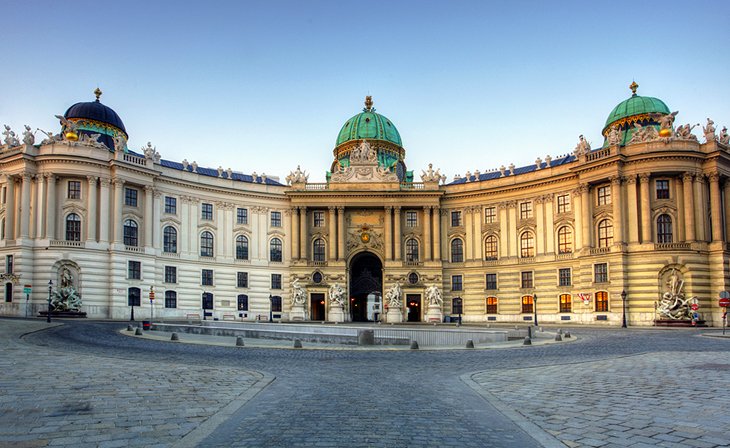
The Hofburg is the former principal imperial palace of the Habsburg dynasty. Located in the centre of Vienna, it was built in the 13th century and expanded several times afterwards. It also served as the imperial winter residence, as Schönbrunn Palace was the summer residence.
he name translates as “Castle of the Court”, which denotes its origins when initially constructed during the Middle Ages. Initially planned in the 13th century as the seat of the Dukes of Austria, the palace expanded over the centuries, as they became increasingly powerful. From 1438 to 1583, and again from 1612 to 1806, it was the seat of the Habsburg kings and emperors of the Holy Roman Empire, and thereafter until 1918 the seat of the Emperors of Austria. Since then the palace has continued in its role as the seat of the head of state and is today used by the Austrian Federal President.
The walls of the Marble Hall in front of the Hall of Ceremonies date back to the 16th century and theoretically belong to the Leopoldine Wing, but the scagliola for the interior was changed around 1840 to match the appearance of the newer Hall of Ceremonies. During the imperial period it was used as a dining room and for balls for the children at court.
The Hall of Ceremonies was built for Emperor Francis II/I by the Belgian architect Louis Montoyer at the beginning of the 19th century. Because of its additional nature, it formed a clearly visible protrusion at right angles to the Leopoldine Wing for almost a hundred years, and was therefore also called the “Nose”.
2.Medieval Burg Hochosterwitz
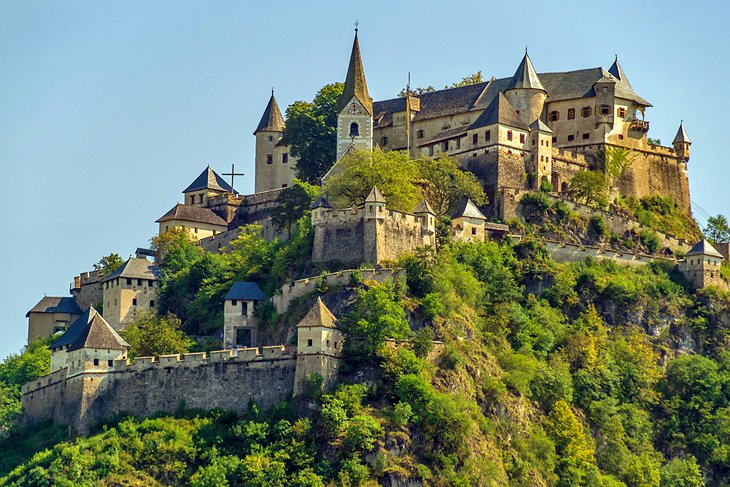
Hochosterwitz Castle is a castle in Austria, considered one of Austria’s most impressive medieval castles. It is on a 172-metre high dolomite rock near Sankt Georgen am Längsee, east of the town of Sankt Veit an der Glan in Carinthia. The rock castle is one of the state’s landmarks and a major tourist attraction.
A settlement site since the Bronze Age, the rock was first mentioned in an 860 deed issued by Louis the German, King of East Francia, donating several of his properties in the former principality of Carantania to the Archdiocese of Salzburg. It was then named ‘Astarwiza’, its name being of Slavic origin. It remained a Salzburg possession, until in the 11th century Archbishop Gebhard of Salzburg ceded the castle to the descendants of Count Siegfried of Sponheim in return for their support during the Investiture Controversy. After Siegfried’s grandson Henry IV became Duke of Carinthia in 1122, the Sponheim rulers were able to shake off the Salzburg overlordship. Later they bestowed the fiefdom upon the ministeriales of the Osterwitz noble family, possibly a cadet branch of the Sponheim dynasty. In 1209 one Herman of Osterwitz, who held the hereditary office of the cup-bearer at the ducal court in Sankt Veit, accompanied Duke Bernhard of Carinthia to the coronation of Emperor Otto IV in Rome.
Since the 16th century, no major changes have been made to Hochosterwitz. It has also remained in the possession of the Khevenhüller family as requested by the original builder, George Khevenhüller. A marble plaque dating from 1576 in the castle yard documents this request.
Some parts of the castle are open to the public every year from Easter to the end of October. Tourists are allowed to walk the 620-metre (2,030 ft) long pathway through the 14 gates up to the castle; each gate has a diagram of the defense mechanism used to seal that particular gate. The castle rooms hold a collection of prehistoric artifacts, paintings, weapons, and armor, including one set of armor 2.4 metres (8 ft) tall, once worn by Burghauptmann Schenk.
3.Belvedere Palace, Vienna
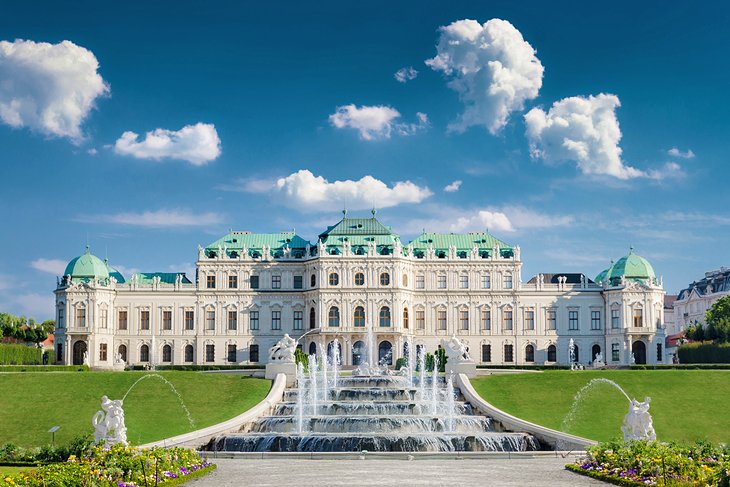
The Belvedere is a historic building complex in Vienna, Austria, consisting of two Baroque palaces (the Upper and Lower Belvedere), the Orangery, and the Palace Stables. The buildings are set in a Baroque park landscape in the third district of the city, on the south-eastern edge of its centre. It houses the Belvedere museum. The grounds are set on a gentle gradient and include decorative tiered fountains and cascades, Baroque sculptures, and majestic wrought iron gates. The Baroque palace complex was built as a summer residence for Prince Eugene of Savoy.
The Belvedere was built during a period of extensive construction in Vienna, which at the time was both the imperial capital and home to the ruling Habsburg dynasty. This period of prosperity followed on from the commander-in-chief Prince Eugene of Savoy’s successful conclusion of a series of wars against the Ottoman Empire.
On 30 November 1697, one year after commencing with the construction of the Stadtpalais, Prince Eugene purchased a sizable plot of land south of the Rennweg, the main road to Hungary. Plans for the Belvedere garden complex were drawn up immediately. The prince chose Johann Lukas von Hildebrandt as the chief architect for this project rather than Johann Bernhard Fischer von Erlach, the creator of his Stadtpalais. Hildebrandt (1668–1745), whom the general had met whilst engaged in a military campaign in Piedmont, had already built Ráckeve Palace for him in 1702 on Csepel, an island in the Danube south of Budapest. He later went on to build numerous other edifices in his service. The architect had studied civil engineering in Rome under Carlo Fontana and had gone into imperial service in 1695–96 in order to learn how to build fortifications. From 1696 onwards, records show that he was employed as a court architect in Vienna. As well as the Belvedere, Hildebrandt’s most outstanding achievements include the Schloss Hof Palace, which was also commissioned by Prince Eugene, the Schwarzenberg Palace (formerly known as the Mansfeld–Fondi Palace), the Kinsky Palace, as well as the entire Göttweig Monastery estate in the Wachau Valley.
4.Skiing at Kitzbühel and Kitzbüheler Horn
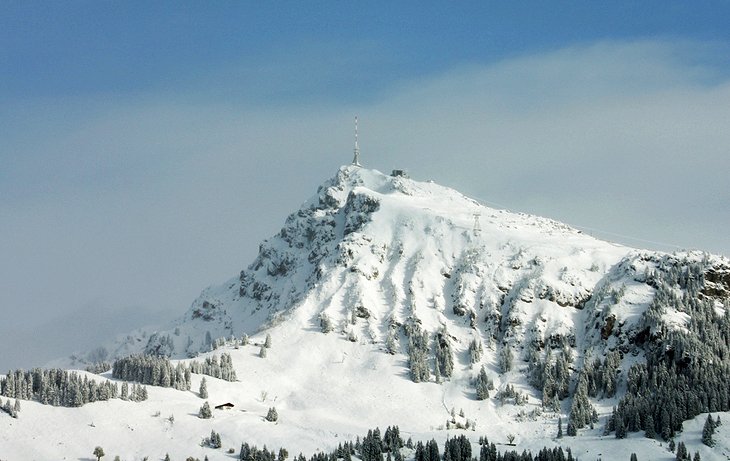
The Kitzbüheler Horn (also spelt Kitzbühler Horn) is a mountain in the Kitzbühel Alps in Tyrol, Austria, whose western flank lies near the smart ski resort of Kitzbühel. With a height of 1,996 m (AA) it only just misses being a ‘two-thousander’.
At the summit is a 102 metre high TV tower belonging to the ORF and known as the Kitzbüheler Horn Transmission Tower (Sendeturm Kitzbüheler Horn). The Harschbichl (1,604 m) is a sub-peak to the north which is also accessible.
One of the best places to ski in Austria, the famed resort town of Kitzbühel spoils snow lovers with its 170 kilometers of skiable pistes and slopes dotted with little mountain huts, where they can stop for traditional Alpine snacks and warming drinks.
Although it’s the site of the annual Hahnenkamm, the toughest of all downhill ski races, Kitzbühel has plenty of terrain for all skill levels in its three skiing areas, and the smallest of these, Bichlalm, is dedicated to freeriders.
But Kitzbühel is not just for skiers. With its walls and frescoed houses, and snow-covered Alps for a backdrop, the town is as pretty as Alpine villages get.
The mountain has several cable cars and gondola lifts and there is a panoramic toll road from Kitzbühel. There are also several mountain inns on its slopes. The so-called Alpenhaus (1,670 m (AA),47°28′01″N 12°25′45″E was in recent years the finish of the King Stage (Königsetappe) of the Tour of Austria cycle race. An Alpine flower garden (Alpenblumengarten) has been laid out at a height of 1800 m which, despite its name, has mountain plants from all over the world. Every year in August the International Kitzbühler Horn Race takes place. The route runs along the 7.4 km long toll road to the Alpenhaus. Its maximum incline in the closing stages is 22.4%. The record time to the Alpenhaus is held by Beat Bräu who completed the race in a time of 29:11 minutes
5.Melk Benedictine Abbey
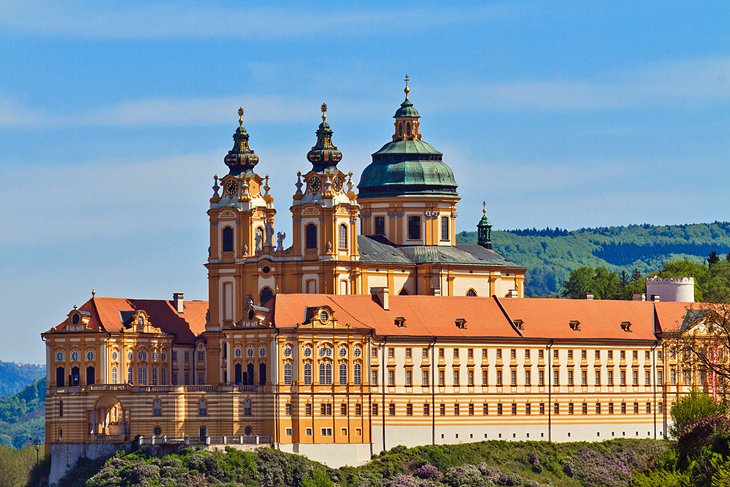
Melk Abbey (German: Stift Melk) is a Benedictine abbey above the town of Melk, Lower Austria, Austria, on a rocky outcrop overlooking the Danube river, adjoining the Wachau valley. The abbey contains the tomb of Saint Coloman of Stockerau and the remains of several members of the House of Babenberg, Austria’s first ruling dynasty.
The abbey was founded in 1089 when Leopold II, Margrave of Austria gave one of his castles to Benedictine monks from Lambach Abbey. A monastic school, the Stiftsgymnasium Melk, was founded in the twelfth century, and the monastic library soon became renowned for its extensive manuscript collection. The monastery’s scriptorium was also a major site for the production of manuscripts. In the fifteenth century the abbey became the centre of the Melk Reform movement which reinvigorated the monastic life of Austria and Southern Germany.
Today’s Baroque abbey was built between 1702 and 1736 to designs by Jakob Prandtauer. Particularly noteworthy are the abbey church with frescos by Johann Michael Rottmayr and the library with countless medieval manuscripts, including a famed collection of musical manuscripts and frescos by Paul Troger.
Due to its fame and academic stature, Melk managed to escape dissolution under Emperor Joseph II when many other Austrian abbeys were seized and dissolved between 1780 and 1790. The abbey managed to survive other threats to its existence during the Napoleonic Wars, and also in the period following the Anschluss in 1938, when the school and a large part of the abbey were confiscated by the state.
6.Hallstatt and the Dachstein Salzkammergut
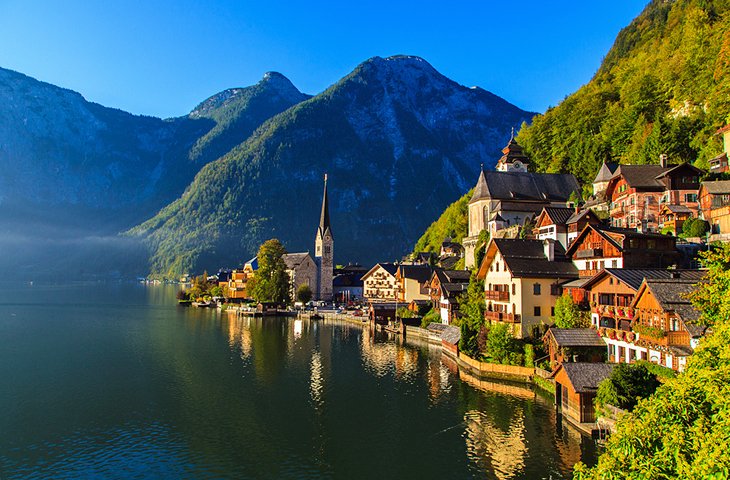
Hallstatt (UK: /ˈhælstæt, ˈhælʃtæt/ HAL-s(h)tat, US: /ˈhɔːlstæt, ˈhɔːlstɑːt, ˈhɑːlstɑːt, ˈhɑːlʃtɑːt/ HAWL-sta(h)t, HAHL-s(h)taht, German: [ˈhalʃtat] is a small town in the district of Gmunden, in the Austrian state of Upper Austria. Situated between the southwestern shore of Hallstätter See and the steep slopes of the Dachstein massif, the town lies in the Salzkammergut region, on the national road linking Salzburg and Graz.
Hallstatt is known for its production of salt, dating back to prehistoric times, and gave its name to the Hallstatt culture, the archaeological culture linked to Proto-Celtic and early Celtic people of the Early Iron Age in Europe, c. 800–450 BC.
Hallstatt is at the core of the Hallstatt-Dachstein/Salzkammergut Cultural Landscape declared as one of the World Heritage Sites in Austria by UNESCO in 1997. It is an area of overtourism.
Hallstatt is undoubtedly one of the most picturesque small towns in Austria, if not Europe. It’s also a good place from which to explore the spectacular Dachstein Salzkammergut region, a UNESCO World Heritage site.
The beautiful Baroque architecture testifies to Hallstatt’s wealth, which is based on its long history of salt production from prehistoric times.
You can also visit the underground salt lake in the nearby Hörnerwerk cavern, or explore the Dachstein Caves, one of Europe’s most impressive cavern networks, which are, in places, up to 1,174 meters deep. Highlights include the Giant Ice Cave, with its sub-zero summer temperatures and huge caverns with magnificent frozen waterfalls, and the Mammoth Cave, with its huge pipe-shaped galleries formed by an ancient underground river.
7.The Grossglockner Road to Franz-Josefs-Höhe
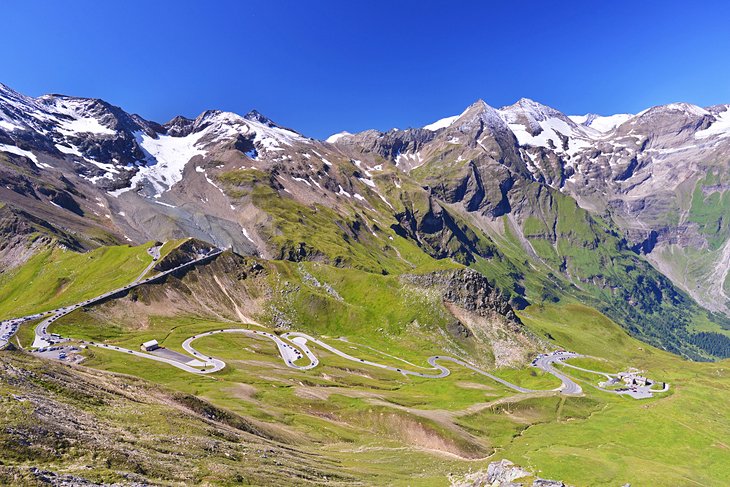
The Grossglockner High Alpine Road (in German Großglockner-Hochalpenstraße) is the highest surfaced mountain pass road in Austria. It connects Bruck in the state of Salzburg with Heiligenblut in Carinthia via Fuscher Törl and Hochtor Pass at 2,504 m (8,215 ft).The road is named after the Grossglockner, Austria’s highest mountain. Built as a scenic route, a toll is assessed for passage.
he road leads from Bruck in the Salzach Valley via the northern toll booth at Ferleiten (near Fusch) with numbered hairpin curves up to Hochtor Pass, with a 1.5 km (0.93 mi) branch-off from Fuscher Törl at 2,428 m (7,966 ft) to the Edelweißspitze viewpoint. The scenic route crosses the Alpine divide in a tunnel and runs southwards passing another branch-off which leads to the Glocknerhaus mountain hut and the Kaiser-Franz-Josefs-Höhe visitors’ centre at 2,369 m (7,772 ft).
The popular overlook was named after a visit by Emperor Franz Joseph I of Austria and his consort Elisabeth in 1856. It offers a panoramic view over the Pasterze Glacier, the Grossglockner massif, the Glocknerwand, and the Johannisberg in the northwest. From here the road runs downhill to the southern toll booth near Heiligenblut.









